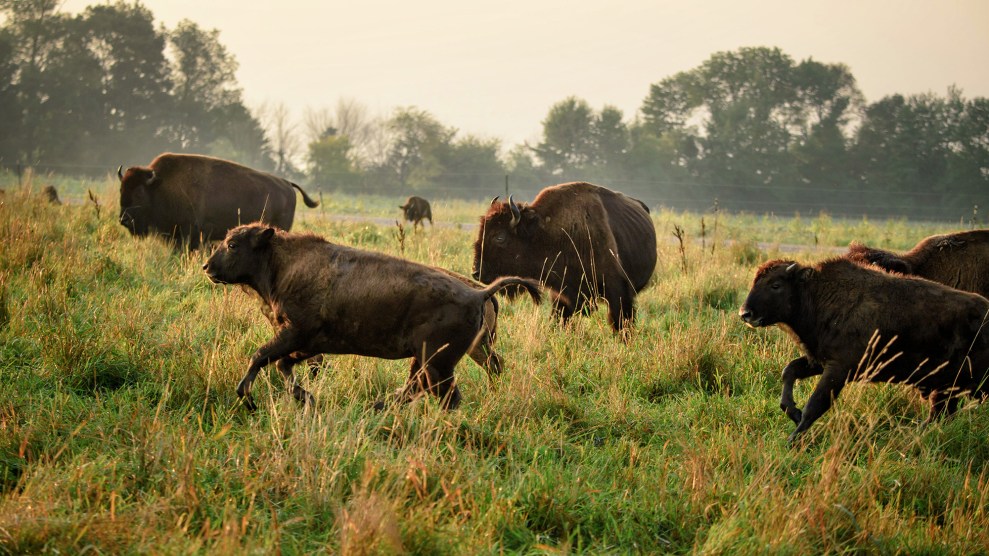
Bison graze at Northstar Bison in Rice Lake, Wisconsin. Northstar Bison is the largest one hundred percent grass fed bison operation in the country.Glen Stubbe/TNS/Zuma
Once a month, Adam Ulbricht hosts a lively podcast called The Bison Insider. Ulbricht, who’s also executive director of the Minnesota Bison Association, discusses weaning calves, the pros and cons of small ranches, and field harvesting. A favorite topic: the rebound of the bison market after a brief Covid slump. Between 2021 to 2022, bison meat production ticked up by 8.5 percent. “We’re processing more animals than we ever have, and that’s to meet a demand,” Ulbricht says, from restaurants, from direct-to-consumer sales, from a snack industry gung-ho about bison jerky. More bison could also feed American troops; the House version of the National Defense Authorization Act, passed this past June, included an amendment introduced by Rep. Ruben Gallego (D-AZ), stipulating that the Pentagon aim to buy 2 million pounds of bison meat a year from Tribal producers. “The voices that I talk to regularly believe that by 2024 we’re very likely looking at a shortage of animals,” Ulbricht says.
Currently, there are some 350,000 head of bison in US herds, around 20,000 of which are managed by tribes for whom the animals are culturally and economically significant. Many ecologists would also like to see these numbers climb. “I think it would be good for the environment,” says Matthew Moran, an emeritus biology professor at Hendrix College in Arkansas who studied the conservation herd at the Tallgrass Prairie Preserve in Kansas. That’s because bison function as “ecosystem engineers,” boosting biodiversity.
Left to their own devices, bison graze in patches, creating grass outcroppings of varying heights that are home to a host of bird species. Their wallowing makes muddy puddles that support other insects and animals. In this way they help revive and maintain the health of grasslands, which store one-third of global terrestrial carbon stocks.
But that only works, says Troy Heinert, executive director of the InterTribal Buffalo Council, an organization representing the interests of Native ranchers, if the animals are allowed to choose, as much as possible, where to roam and what to graze. Moving bison in an intensive rotational system like is done with some cattle, where paddocks rest and recover between bouts of munching, prevents the overgrazing that results in soil erosion and compaction; some studies show this practice has similar land benefits for both species—though bison emit less of the potent greenhouse gas methane.
Yet in most parts of the country, it’s hard to maintain year-round grazing. For this reason, many bison producers—both Native and non-Native—finish animals on grain for 2 to 3 months before slaughter, which can detract from the ungulates’ overall environmental benefits. Additionally, the grain that’s used for finishing—largely corn and soy—requires heavy water usage and causes fertilizer pollution and loss of ecosystems as land is converted to crop fields.
Still, with enough viable land and sound management, bison producers could theoretically raise more meat and keep the eco-benefits. Hila Shamon, a research ecologist with Smithsonian’s National Zoo and Conservation Biology Institute calls out the ranchers at Diamond 4D Ranch in Choteau, Montana. Under the guidance of manager Chris Bechtold, they use a rotational system where “instead of pushing [bison] from one area to another, they open up the gates to the next pasture and give them the choice to either stay or move to the next pasture.” This creates species-rich heterogeneity as the animals nibble grasses into those patches of differing heights.
As climate change intensifies, ecologically-minded ranchers like those at 4D are finding it harder to accommodate their bison’s grazing needs—and therefore rise to meet the consumer demand that Ulbricht, the podcaster, noted. 4D’s animals are raised strictly on food they find (bison can paw away winter snow to get to dead plants beneath). But two years’ worth of intense drought in the West have decimated grasses. Bechtold was forced to cull the 1,200-head herd by half.
If more producers jump in to meet consumer demand, the Inter-Tribal Buffalo Council’s Heinert worries that the environmental benefits could evaporate, with bison causing the same problems as cattle. “You have to use the lands you have available,” he says, “to let buffalo be buffalo.”













